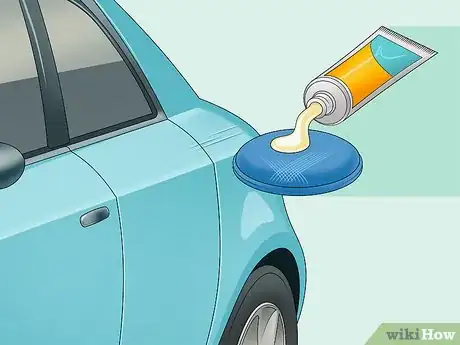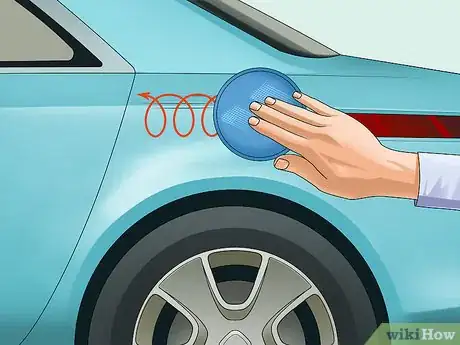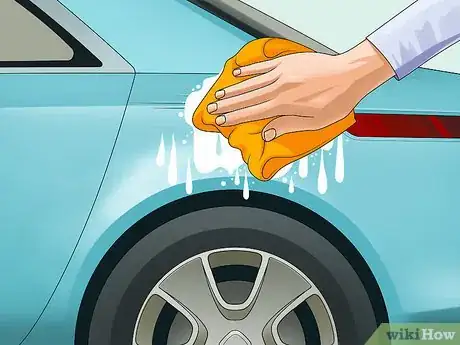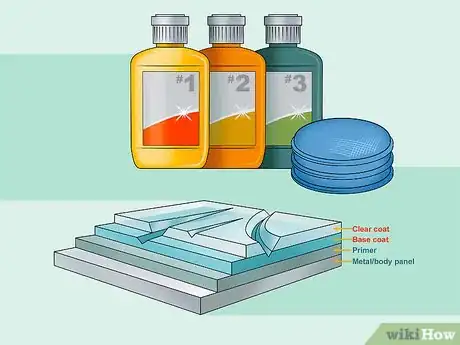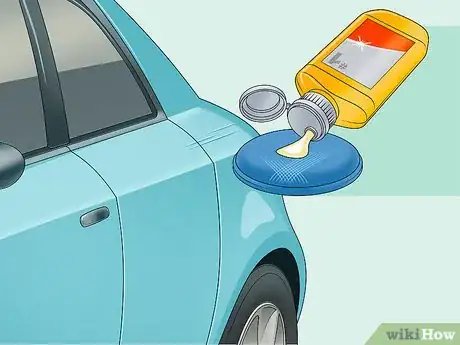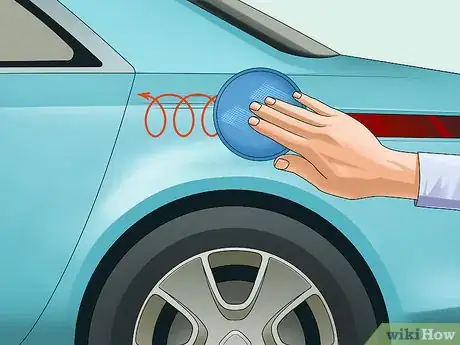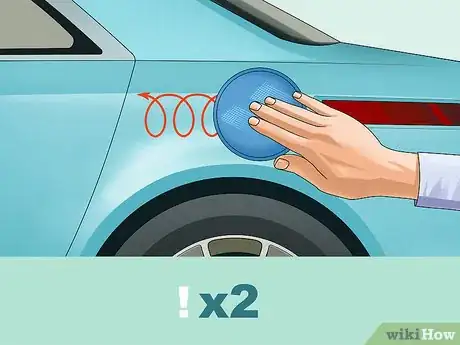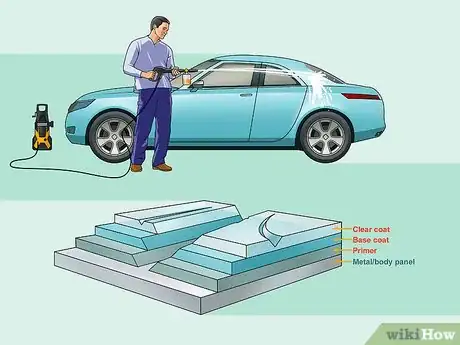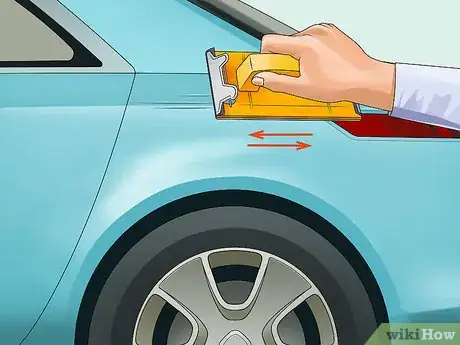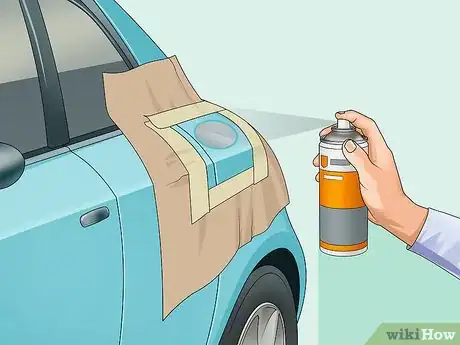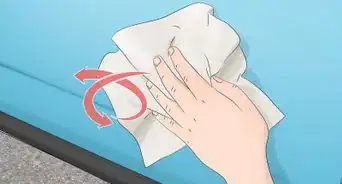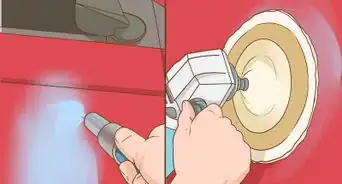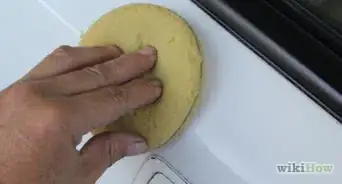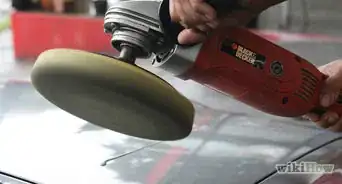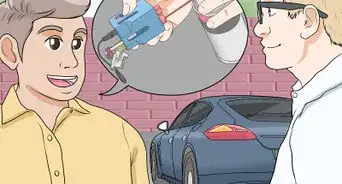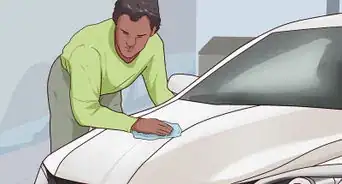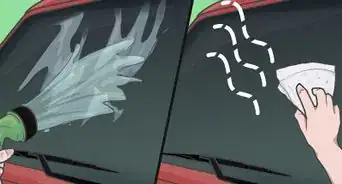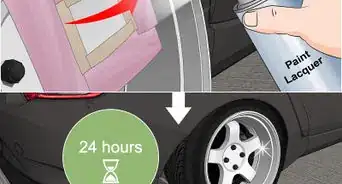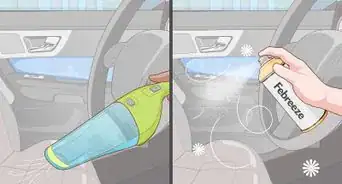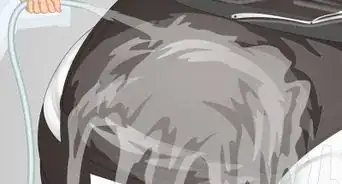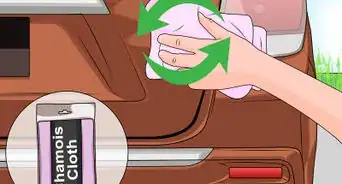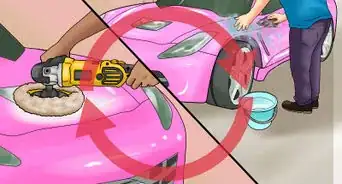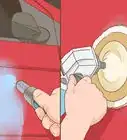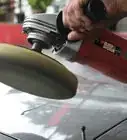This article was co-authored by Chad Zani. Chad Zani is the Director of Franchising at Detail Garage, an automotive detailing company with locations around the U.S. and Sweden. Chad is based in the Los Angeles, California area and uses his passion for auto detailing to teach others how to do so as he grows his company nationwide.
There are 10 references cited in this article, which can be found at the bottom of the page.
wikiHow marks an article as reader-approved once it receives enough positive feedback. In this case, 83% of readers who voted found the article helpful, earning it our reader-approved status.
This article has been viewed 2,372,425 times.
Scratches in car paint can be caused by a variety of things. Car accidents, vandalism, poor parking, and other parking lot mishaps are all common causes for a scratch or 2 on your perfect paint job. While scratches do detract from the appearance of your car, paying a body shop for a new coat of paint or even a small touch-up can be costly. You can try buffing out surface scratches with toothpaste, using a scratch removal product for small scratches, or sanding and repainting the area if the scratch is deep.
Steps
Using Toothpaste for Surface Scratches
-
1Run a fingernail over the scratches to see if they are surface or deep. If your fingernail does not catch on the scratches, then they are on the surface and using toothpaste might be a good option. If your fingernail does catch on them, then they are deeper and you will need to use a professional scratch removal product.[1]
-
2Wash and dry the scratched area. Before you apply toothpaste to the scratches, make sure that the area is very clean. Rubbing dirt and debris into the scratched area will make the scratches worse.[2]
- You can take your car to a car wash or wash it yourself.
- To wash your car yourself, spray it with a hose to wet it all over and remove the majority of the dirt and debris. Then, use a large sponge or car-washing brush to apply soap formulated for vehicles to your car. Work the soap into all surface of your car and then use the hose to spray it off. Dry your car with a clean, dry towel.
Advertisement -
3Apply a quarter-sized amount of toothpaste to a dampened microfiber towel. Get the microfiber towel wet enough so that it is just damp. Then, apply a quarter-sized amount of the toothpaste to the towel, or a little more or less depending on the size of the scratch.[3]
- Whitening toothpaste works best, but you can try removing the scratches with any toothpaste you have on hand.
- You will need to apply the toothpaste with a soft, clean, microfiber towel to ensure that rubbing in the toothpaste does not cause more damage.
-
4Rub the toothpaste into the scratched area using a circular motion. Push down on the microfiber cloth and move it in small circles to buff out the scratches. Do this until the toothpaste is well-distributed on the surface.[4]
- You will need to apply some pressure as you apply the toothpaste, but not too much.
-
5Rinse off any excess toothpaste. After you finish buffing out the scratches, rinse the area thoroughly to remove the excess toothpaste. Spray your car with a hose and then dry the area with a microfiber towel.[5]
- You can also wipe away the excess toothpaste with a wet microfiber towel.
-
6Repeat the process up to 2 more times. You may need to do more than 1 application to get rid of surface scratches using toothpaste. Check the area to see if the scratches are still visible and then repeat the process 1 or 2 more times if needed.
- Make sure that you do not do more than 3 applications or you may damage the clear coat of the car’s paint.
Using a Scratch Removal Product for Small Scratches
-
1Wash your car so there is no dirt or debris left in the scratch. It is important to make sure that the area is completely clean before you apply any product to it or try to buff the area. Any dirt or debris left on the surface when you buff it will result in more scratches.[6]
- Spray your car with a hose before applying any soap to it. Then, use a sponge or brush meant for washing cars to work the soap in. Rinse the soap off completely and dry your car with microfiber towels. Be sure to use soap designed for washing cars.
-
2Purchase a scratch-removal product or kit. You can buy scratch-removal products at auto supply stores or in the auto supply section of large one-stop stores. These products are often sold as a scratch-removal kit that includes the scratch-removal solution and a buffing pad to apply the product.[7]
- If you are unsure about what types of scratch removal product to buy, ask a sales associate for help. Employees who work in auto supply stores are usually knowledgeable about these products.
- A microfiber towel is often a good choice for applying scratch removal products since they are gentle on the surface of your car.
- Some products even come with a mechanical buffing tool that you can use to get rid of the scratches.
EXPERT TIPChad Zani is the Director of Franchising at Detail Garage, an automotive detailing company with locations around the U.S. and Sweden. Chad is based in the Los Angeles, California area and uses his passion for auto detailing to teach others how to do so as he grows his company nationwide.Auto Detailing Expert
 Chad Zani
Chad Zani
Auto Detailing ExpertScratch repair pens are best for light scratches in the car's clear coat. However, if the scratch is so deep it's into or past the paint, you'll probably need to go to a body shop.
-
3Apply a quarter-sized dollop of scratch-removal product to the pad. You may need a little more or less depending on the size of the scratched area. Squirt the product onto the buffing pad or microfiber cloth, and then fold it in half to work the product around the surface of the pad or cloth.[8]
- Make sure that the product is evenly distributed on the cloth or pad before you begin.
-
4Work the product into the scratched area and the surrounding areas. You can work the product in using a circular motion or a back and forth motion. Do what is most comfortable for you and what covers the scratched area best, but do not switch directions! Only go back and forth or in circles. Continue to work in the product for a few minutes so that it is well distributed.[9]
- Make sure to apply light to medium pressure as you work in the product.
-
5Wipe away the product residue. After you have finished buffing the scratched area, use a clean microfiber cloth to wipe away the excess product. Buff the surface of the car where you applied the product using a circular motion.[10]
- Do not allow the excess product to dry on the surface of your car.
- Check the manufacturer’s instructions to be sure about how to remove the excess product.
-
6Repeat 2 to 3 times if needed. Check the area to see if the scratches are still visible. If they are, then you can repeat the product application 2 to 3 times. Just be careful not to do this too many times or you may damage the clear coat on your car.
- Check the manufacturer’s instructions before proceeding with another application.
Painting to Fix Deep Scratches
-
1Wash and dry the car thoroughly. If your car is dirty during scratch repair, that dirt could create more scratches. Wash your car thoroughly to remove all of the dirt and debris. You may want to rinse the scratched area a couple of extra time to be certain that it is clean.
- Pay particular attention to the area you will be repairing. Spray the scratched area with water, making sure to get any debris out of the scratch. Then, clean the area well with soap formulated for use on cars and rinse it all away with clean water.
-
2Sand the scratched area to strip away the top layers of paint. Wrap 2000-grit wet/dry sandpaper around a sanding pad (a holder for the sandpaper with a handle on it) and begin sanding the scratched area.[11] Sand for 10 to 15 seconds at a time and then check the area to see if you need to sand deeper.
- Always sand in the direction of the scratch. You do not want to create opposing scratches, which will only add more ridges and valleys in the paint that need to be repaired.
- Rinse the area with water as needed to check your progress. This will allow you to better see if you have gotten to the bottom of the scratch.
- If the scratch is slightly deeper than the clear coat, use 1500-grit sandpaper to level the surface and then 2000-grit sandpaper to remove the scratches made by the coarser sandpaper.
- Avoid getting dirt or debris between the sandpaper and the vehicle. This will cause scratching.
-
3Rinse and dry the area. Rinse away the debris left by sanding the scratched area. Then, use a clean microfiber cloth to wipe the surface dry.
- Avoid using old or dirty rags since these could cause more scratches on the surface of your car.
-
4Spray a few coats of primer onto the sanded areas. Get some sandable primer in an aerosol can. Spray the primer onto the area you have just sanded. Use a back and forth motion to spray on the paint. Then, wait 5 to 10 minutes for the primer to dry and spray on another layer. Do this a total of 3 times.[12]
- Choose a primer that is close to the color of your car’s paint, if possible. It will not be an exact match, but your paint will be.
-
5Apply a few coats of paint that match your car. Next, spray on the same color paint as is on the rest of your car to the area where you applied the primer. Wait 5 to 10 minutes between each application so that the paint dries completely.[13]
- To ensure that the paint will match, check with your car’s manufacturer to get the same shade of paint. You may be able to purchase the paint from an auto supply store, or you may have to special order the paint from your car’s manufacturer.
-
6Wax the area to seal the paint you have repaired. Apply a high-quality carnauba wax to the surface of your car and then buff the area with a buffer pad or microfiber cloth. You can purchase a waxing kit that includes everything you need to wax your car, such as the wax and a buffing pad or microfiber cloth.
- Apply a quarter-size amount of wax to the buffing pad or cloth to start and add more if needed.
- Use circular motions and press down on the pad or cloth with medium pressure.
- Keep going until the wax is evenly distributed and the car’s surface looks shiny.
Community Q&A
-
QuestionWhat is a good quality rubbing compound for scratches?
 Community AnswerMeguiar’s Ultimate Compound -- this is the best on the market.
Community AnswerMeguiar’s Ultimate Compound -- this is the best on the market. -
QuestionHow can I remove scratches from a car bumper?
 Cleton DiasCommunity AnswerAs bumpers are fiber you can't repair them much, but if the scratch is minor you can try the above method and see.
Cleton DiasCommunity AnswerAs bumpers are fiber you can't repair them much, but if the scratch is minor you can try the above method and see. -
QuestionI have been using T-Cut, but it seems to leave a faded area around it. What should I do?
 Community AnswerThe best one to use is Meguiar’s Ultimate Compound -- try switching to that.
Community AnswerThe best one to use is Meguiar’s Ultimate Compound -- try switching to that.
Warnings
- If the scratches in your car's paint are deep or excessive, you may want to consider going to a body shop to get them repaired. Auto body shops have the professional set up and know-how to give your car a beautiful, shiny new surface.⧼thumbs_response⧽
Things You'll Need
Using Toothpaste for Surface Scratches
- Soap
- Hose
- Sponge
- Microfiber towels
- Toothpaste
Using a Scratch Removal Product for Small Scratches
- Soap
- Hose
- Sponge
- Microfiber towels (to dry your car)
- Scratch removal kit
- Buffing pad or microfiber towel
Painting to Fix Deep Scratches
- Soap
- Hose
- Sponge
- Microfiber towels (to dry your car)
- 1500- and 2000-grit sandpaper
- Sanding pad
- Sander
- Sandable spray primer
- Spray paint that matches your car’s existing paint
- Car wax
References
- ↑ https://www.wired.com/story/car-scratch-repair-kits/
- ↑ https://www.ncconsumer.org/news-articles-eg/remove-car-scratches-with-toothpaste.html
- ↑ https://www.ncconsumer.org/news-articles-eg/remove-car-scratches-with-toothpaste.html
- ↑ https://www.ncconsumer.org/news-articles-eg/remove-car-scratches-with-toothpaste.html
- ↑ https://www.ncconsumer.org/news-articles-eg/remove-car-scratches-with-toothpaste.html
- ↑ https://www.youtube.com/watch?v=m6i8rBrv9Es&feature=youtu.be&t=36s
- ↑ https://www.youtube.com/watch?v=m6i8rBrv9Es&feature=youtu.be&t=1m6s
- ↑ https://www.youtube.com/watch?v=m6i8rBrv9Es&feature=youtu.be&t=1m2s
- ↑ https://www.youtube.com/watch?v=m6i8rBrv9Es&feature=youtu.be&t=1m30s
- ↑ https://www.youtube.com/watch?v=m6i8rBrv9Es&feature=youtu.be&t=2m7s
- ↑ http://www.popularmechanics.com/cars/how-to/maintenance/4216365
- ↑ https://www.popularmechanics.com/cars/how-to/g173/how-to-fix-a-car-paint-scratch/
- ↑ https://www.popularmechanics.com/cars/how-to/g173/how-to-fix-a-car-paint-scratch/
- Videos provided by milanmastracci
About This Article
To remove a surface-level scratch from your car, try using non-gel toothpaste. First, spread a thick layer of the toothpaste over the scratch with a cloth. Then, use a clean toothbrush to work the toothpaste into the scratch. When you've thoroughly brushed the area, rinse off the toothpaste, and the scratch should be gone. For deeper scratches, try using sandpaper. First, sand the scratched area with 2000-grit sandpaper until the surface of your car feels rough. Then, rinse off the area and wipe it dry with a cloth. Next, spray the area you sanded with auto-body primer, and let it dry for 20 to 30 minutes. Once it’s dry, spray the area with auto-body paint that matches the color of your car. Finally, seal the paint with wax or polish. If nothing else is working, try using a car scratch remover kit. For more details about how to use each of these methods, keep reading!


